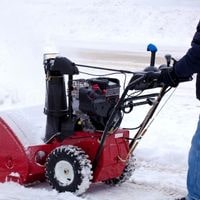Cub Cadet Snowblower Won’t Start. Winter means that homeowners in the north have to focus on keeping their driveways and sidewalks clear of snow instead of green lawns and gardens.
It’s mostly up to you how much time you spend in the garden or mowing the lawn during the summer. You must deal with snow soon after work and before work during the winter. When your Cub Cadet snowblower won’t start, it can be frustrating.
Cub Cadet Snowblower Won’t Start
This article discusses some troubleshooting tips for cub cadet snowblowers that won’t start.
Starter Issue With Recoil
When the starter rope is pulled in and released, the recoil spring recoils onto a pulley. If the recoil spring happens to be broken or if it’s too loose, then the starter rope won’t be able to recoil effectively.
The snowblower won’t start as a result. Any number of reasons may cause this problem. On some vehicles, especially trucks, the recoil starter assembly must be replaced as a whole rather than just bits and pieces of it.
Faulty Ignition Coil
The ignition coil sends voltage to spark plugs while the engine is running. A defective ignition coil may prevent the engine from starting.
Make sure that your spark plug is working well by removing it even if you have confirmed that your spark plug is ok then check it with an ignition coil tester.
The ignition coil should be replaced if it is defective. When replacing an old spark plug with a new one, make sure you use a wire brush to remove any of the electric insulators.
Defective Flywheel Key
The flywheel key might have sheared or snapped in half. This is a metal piece that helps align and engage the crankshaft and flywheel properly.
With this in mind, if the engine stops suddenly from hitting hard objects, it is possible for the flywheel key to snap in half to help prevent the crankshaft from potential damage.
To find out if it has indeed become sheared, remove the flywheel and inspect the key where there should be two full pieces. If there are two full pieces as described above, it’s best to replace them with an exact match as needed.
Error With The Spark Plug
The ground electrode and insulator of the spark plug should be inspected for damage. If you see evidence that the ground electrode is burned away or damaged, replace the spark plug. Also, examine the insulator.
If there are cracks present in it, as well as any carbon buildup around it in particular then this indicates that a replacement is needed due to risks involved such as those relating to high voltage.
Check your spark plug using a spark-plug tester to determine whether it is defective.
You should see a strong spark between its terminals when the engine is cranking on; if not, this signifies that you have either a faulty spark plug or an issue with your ignition coil/module which could mean that it will require changing before operation can resume.
Related Guides
